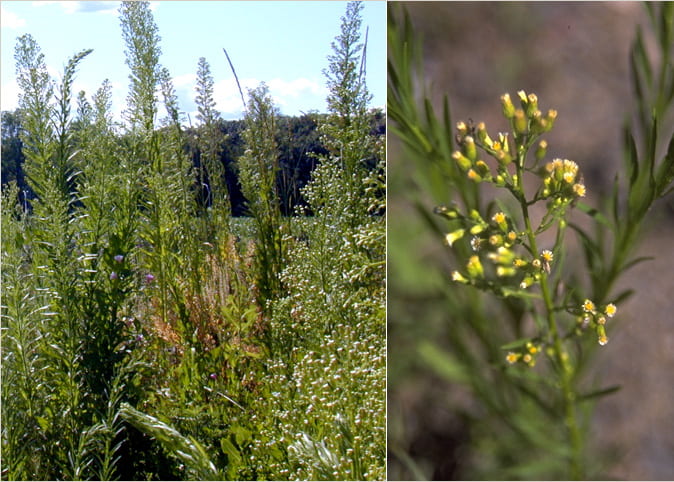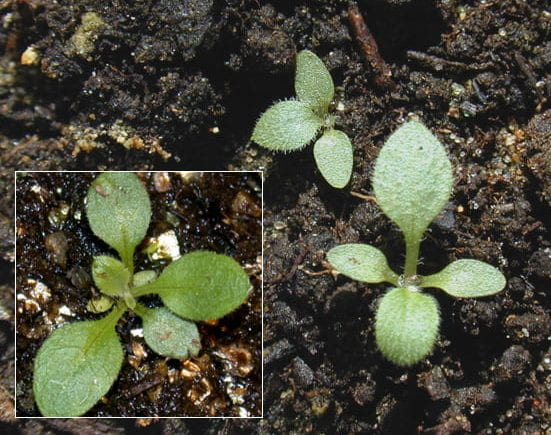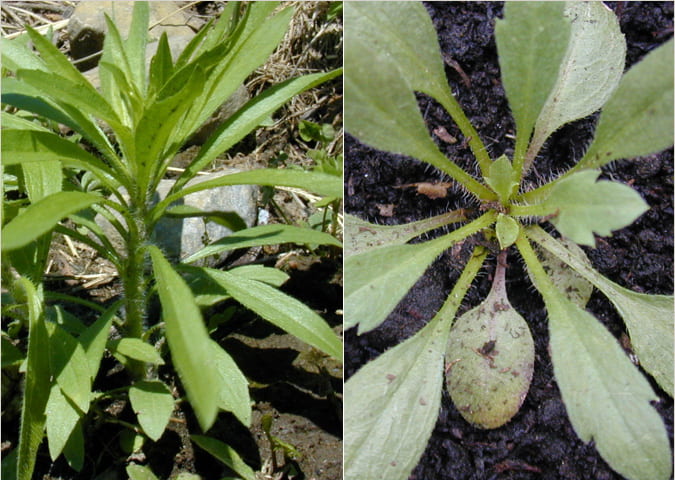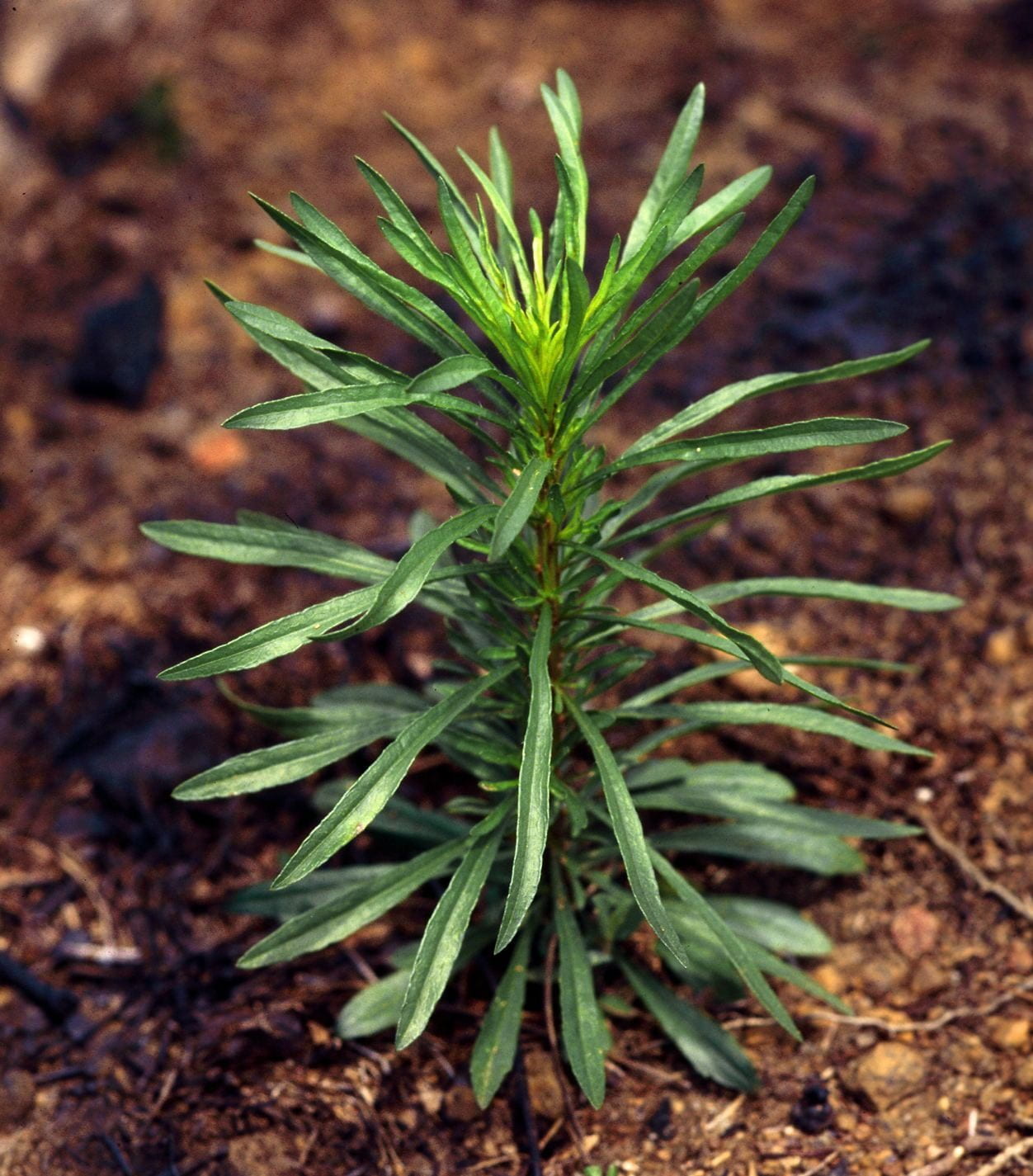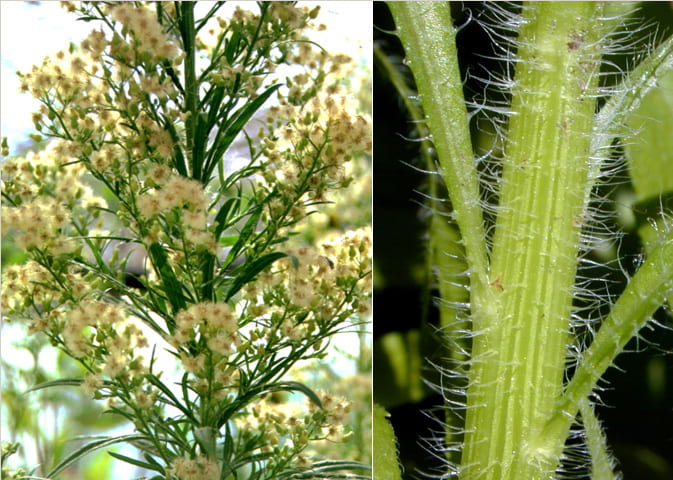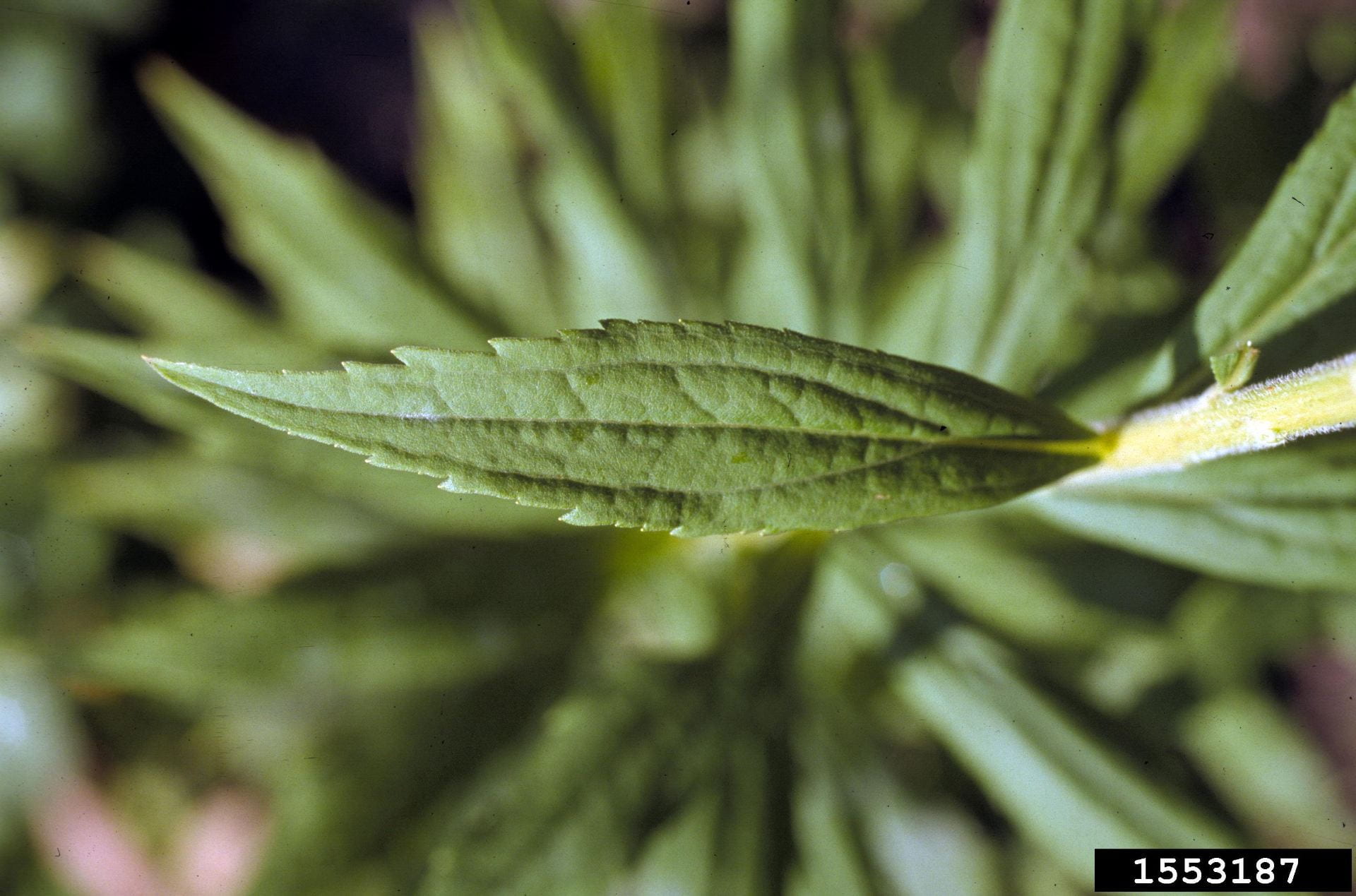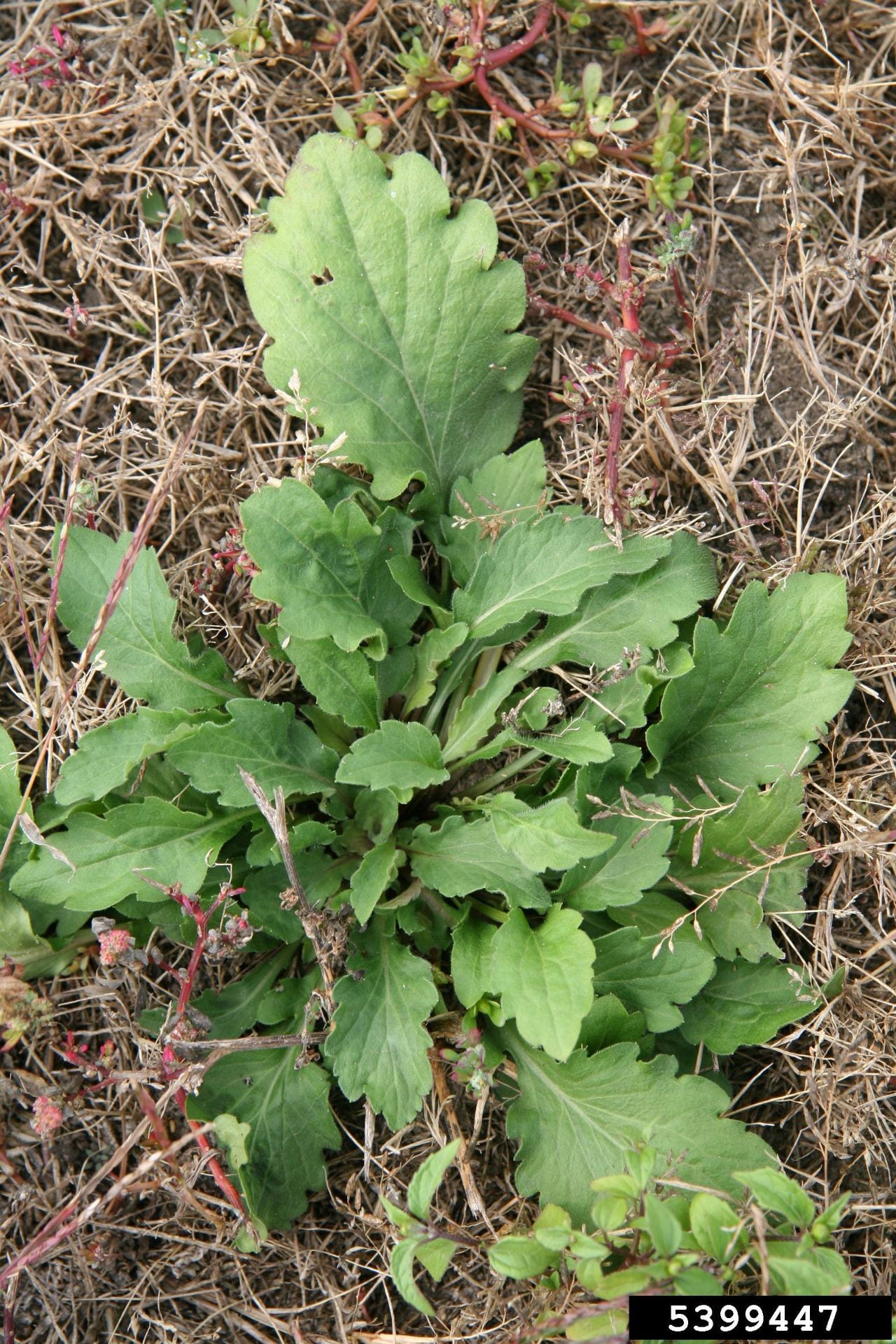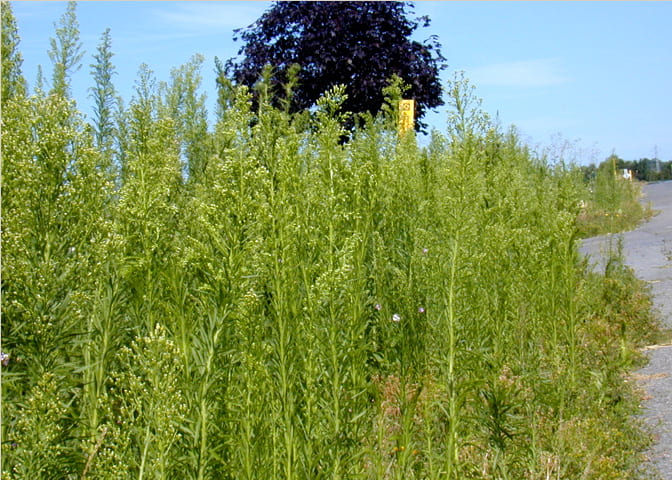Horseweed or marestail (Conyza canadensis) is a widespread and common agricultural and landscape weed in New York, where it is a problem in grape, berry, apple, vegetable, and field crop operations. It is a tall, unbranched annual weed with many long, narrow leaves, small white flowers, and tiny dandelion-like seedheads. Horseweed has flexible germination timing, emerging in the fall, spring, and occasionally summer. This weed is an increasing problem in New York agriculture, because some populations are displaying resistance to glyphosate and ALS inhibiting herbicides.
Identification
Seedlings: Horseweed emerges in the fall, spring or summer. Cotyledons are less than 1/10″ long and egg-shaped, while the first true leaves are larger, densely hairy, pointed ovals. Seedlings develop in a basal rosette with long leaves with scalloped edges. Fall-germinating plants overwinter in this form.
Mature plant: As plants mature, it forms a single, hairy stem up to six feet tall (Photo 4), with alternate leaves that are long, narrow, hairy, irregularly toothed, baseball-bat shaped leaves that lack petioles (Photo 3).
Horseweed rosette and early bolting phase.
Photo by A DiTomasso, from “Weed Identification, Biology and Management” by A DiTommaso and A K Watson.
Flowers: At the top of the plant, the stem branches to produce tiny white daisy-like flowerheads (Photo 4).
Similar species: Goldenrods have similar growth habit, size, and leaf shape, but leaves are widest at the middle rather than at the end, hairs are very small on goldenrod, and flowers are yellow rather than white. Annual fleabane is very similar, but has more egg-shaped than baseball-bat shaped leaves and shorter hairs held closer to the leaf.
Canada goldenrod leaf, showing near-parallel veination.
Image by Theodore Webster of USDA-ARS, via bugwood.org.
Management
Chemical control
Cornell University’s Turfgrass and Landscape Weed ID app offers suggestions for conventional and alternative chemical control options. Take Action’s horseweed page has extensive management suggestions for herbicide resistant horseweed in soybeans.
Use this tool to look up the efficacy of herbicides on a particular weed species. For general guidance on weed control, get the latest edition of the Cornell Crop and Pest Management Guidelines.
Non-chemical control
Cornell University’s Charles Mohler suggests tillage, crop competition, and careful management of horseweed in non-crop areas to prevent reestablishment. Horseweed is a prolific seed producer, but the seeds are not long-lived, so plowing that inverts the soil will eliminate seeds, and new seedlings are readily controlled with tine weeding. Once plants are well established, tine weeding is much less effective. Strongly competitive crops can outcompete horseweed, which is more of a problem in less competitive crops like onions and carrots. Management in non-crop areas helps reduce reseeding from this wind-dispersed weed.
See A Grower’s Guide to Organic Apples from Cornell for non-chemical weed control options in apple orchards.
Herbicide Resistance
Horseweed has evolved resistance to a variety of herbicides; in the U.S., resistance to glyphosate (Group 9) and ALS inhibitors (Group 2) are widespread, as are populations that are resistant to both. Mike Hunter from Cornell’s field crops extension team is conducting a study in 2020 to explore the current state of resistance in several NYS horseweed populations. NYS IPM has a brief summary and a great identification photo-guide fpr horseweed and goldenrod in the NYS IPM weekly field report from Sept 2018.
Climate Change and Management
Horseweed, under drought conditions, thrives with increased height growth and seed production. Despite a 40% mortality rate, it benefits from reduced competition with native species which are also damaged in drought conditions. Horseweed shows faster glyphosate translocation out of leaves under drought conditions and higher CO2, reducing the number of horseweed plants effectively controlled by glyphosate.
# of studies referenced in this section: 2
References
Uva R H, Neal J C, DiTomaso J M. 1997. Weeds of the Northeast. Book published by Cornell University, Ithaca NY. The go-to for weed ID in the Northeast; look for a new edition sometime in 2019.
Cornell University’s Weed Ecology and Management website. Contains a wealth of information on ecological management of agricultural and garden weeds. Look for a revamp of this site in 2020 or 2021.
Cornell University’s Turfgrass and Landscape Weed ID app. Identification and control options for weeds common to turf, agriculture, and gardens in New York; uses a very simple decision tree to identify your weed.
Take Action website horseweed management page, accessed June 27, 2019. Website devoted to successful management of herbicide resistant weeds and the adoption of practices that reduce the development of new herbicide resistant weed populations.
The Grow integrated pest management website, accessed November 4, 2019.
Peck, G M and I A Merwin. A Grower’s Guide to Organic Apples. Covers organic weed control methods for organic apple orchards.
Breth, D I and E Tee. 2016. Herbicide AI by Weed Species. This tool allows you to look up the efficacy of an herbicide active ingredient on a particular weed species.
Mojzes, A. et al. (2020) ‘Experimental drought indirectly enhances the individual performance and the abundance of an invasive annual weed’, Oecologia, 193(3), pp. 571–581. doi:10.1007/s00442-020-04711-y.
Matzrafi, M. et al. (2019) Increased temperatures and elevated CO2 levels reduce the sensitivity of Conyza canadensis and chenopodium album to glyphosate, Nature News.

